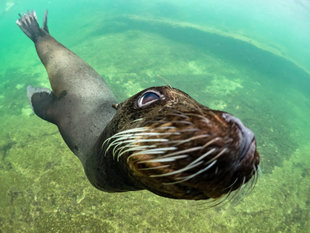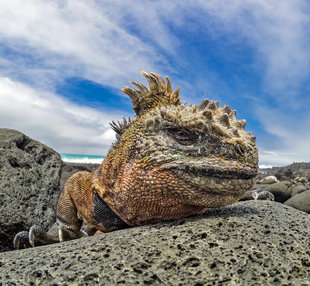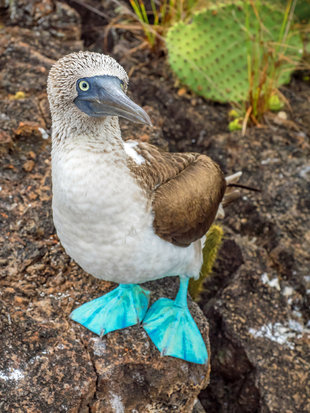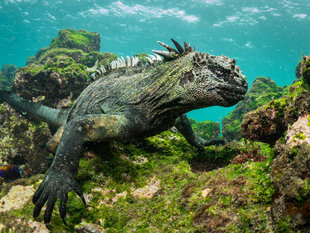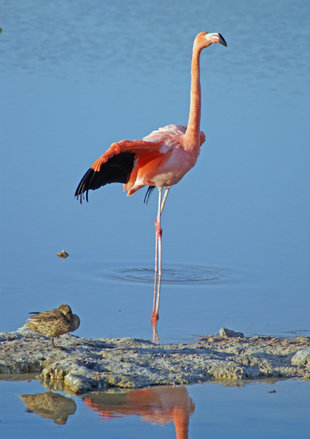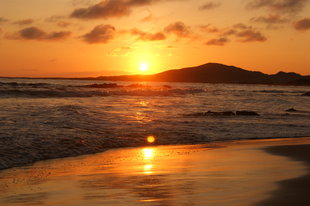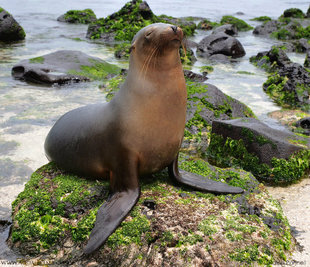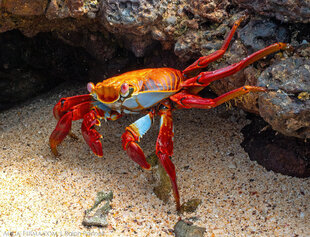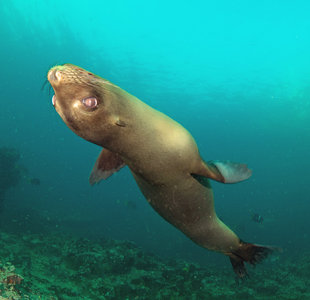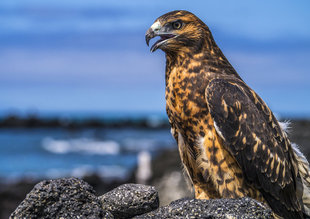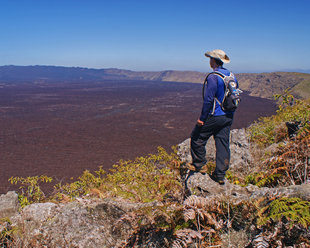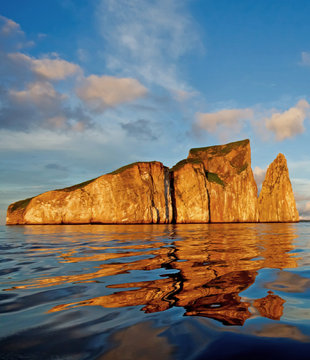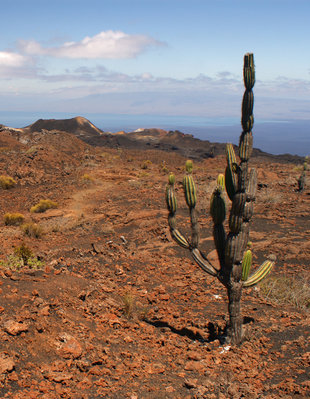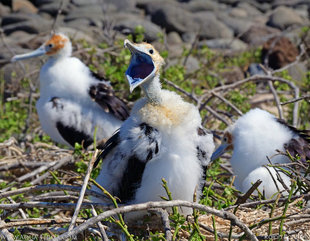This land-based Galapagos Wildlife, Marine Life & Photography journey will be hosted by Aqua-Firma director & photographer, Ralph Pannell, who has been working in conservation and travel in Ecuador & the Galapagos for more than 20 years; plus local guides trained by the Charles Darwin Research Station. The journey will take you snorkeling with sharks, rays, turtles & more; see a vast array of the Galapagos feature wildlife, such as giant tortoises, penguins, sealions, blue-footed boobies; and experience some of its stunning volcanic landscape, learning how life came to exist in this remote ocean archipelago.
Volcanic Scenery
The most expansive volcanic scenery in the Galapagos is on the largest and perhaps most beautiful island of Isabela. This is where we find the Sierra Negra Volcano, which reaches 1,124 metres above sea level. Lava flows as recent as 2018 can be seen here, whilst the most recent dramatic changes to the area occurred in 2005 when the BBC were filming a four-part series about the islands. The centre of the explosions was a parasitic cone called Cerro Chico - the target point for a trek we will make. Scratch the Earth's surface just a few inches below the lava surface here and the temperature is too hot to touch. The landscape is one of multicoloured igneous rock, oozing in places with sulphurous fumes. We have to stick strictly to tested pathways here: as with so much of the Galapagos, the lava has solidified above a Swiss cheese network of gas bubbles.
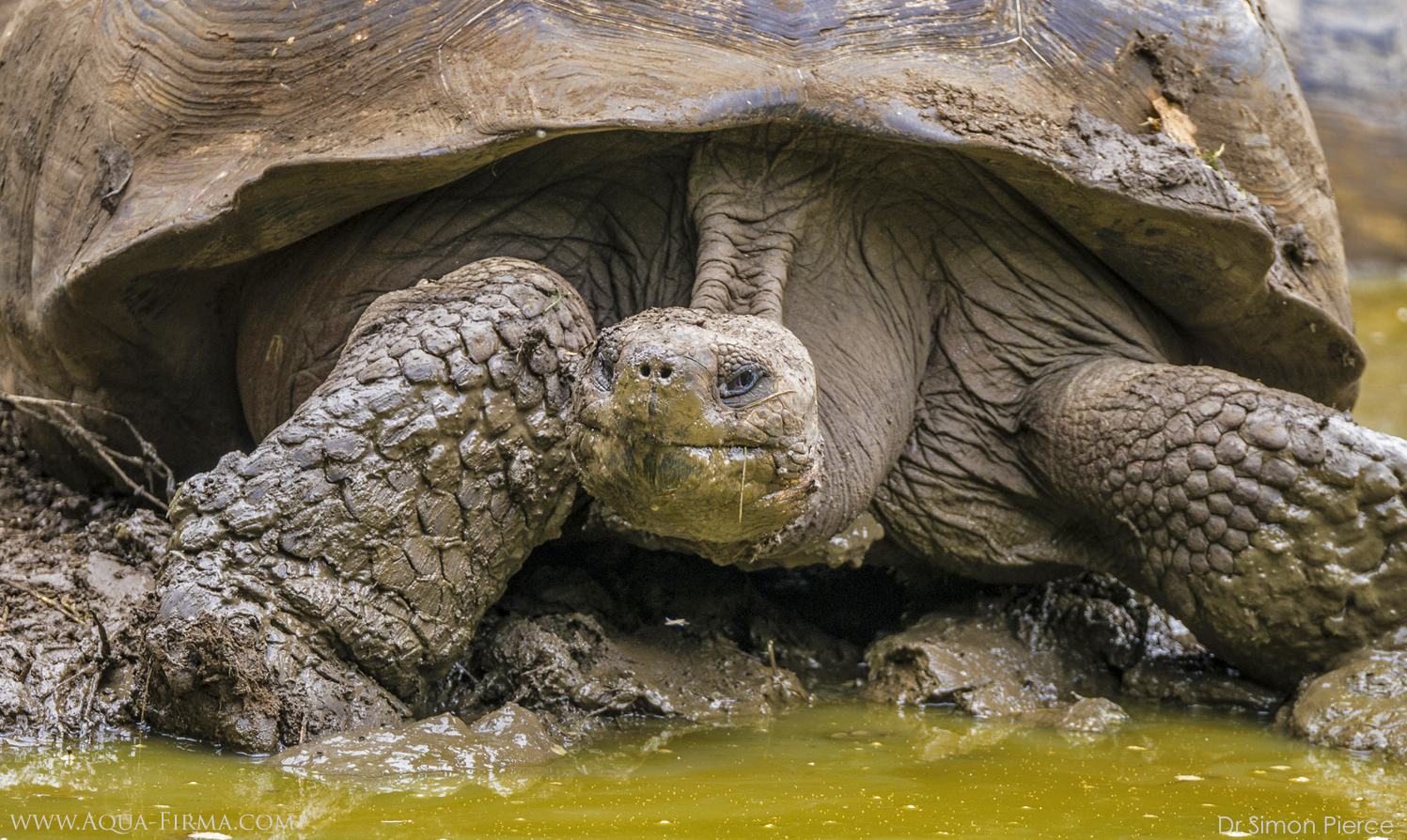
To reach Cerro Chico, we will trek along part of the second largest volcanic crater in the World, measuring 6 miles across. Only the Ngorongoro Crater in Tanzania is wider. Cloud cover is highly variable here, with the best conditions when skies are clear above clouds, pushed up by the wind before cascading over cliffs into the huge crater. These clouds sustain a gnarly cloud forest on the slopes of Sierra Negra, where we can sometimes find endemic Galapagos Hawks and Mockingbirds.
We will also take you into the Highlands of San Cristobal Island, where we find extinct and weathered volcanic peaks, as well as opportunities to see Giant Tortoises and Frigatebirds uniquely skimming into a volcanic lake to clean their wings.
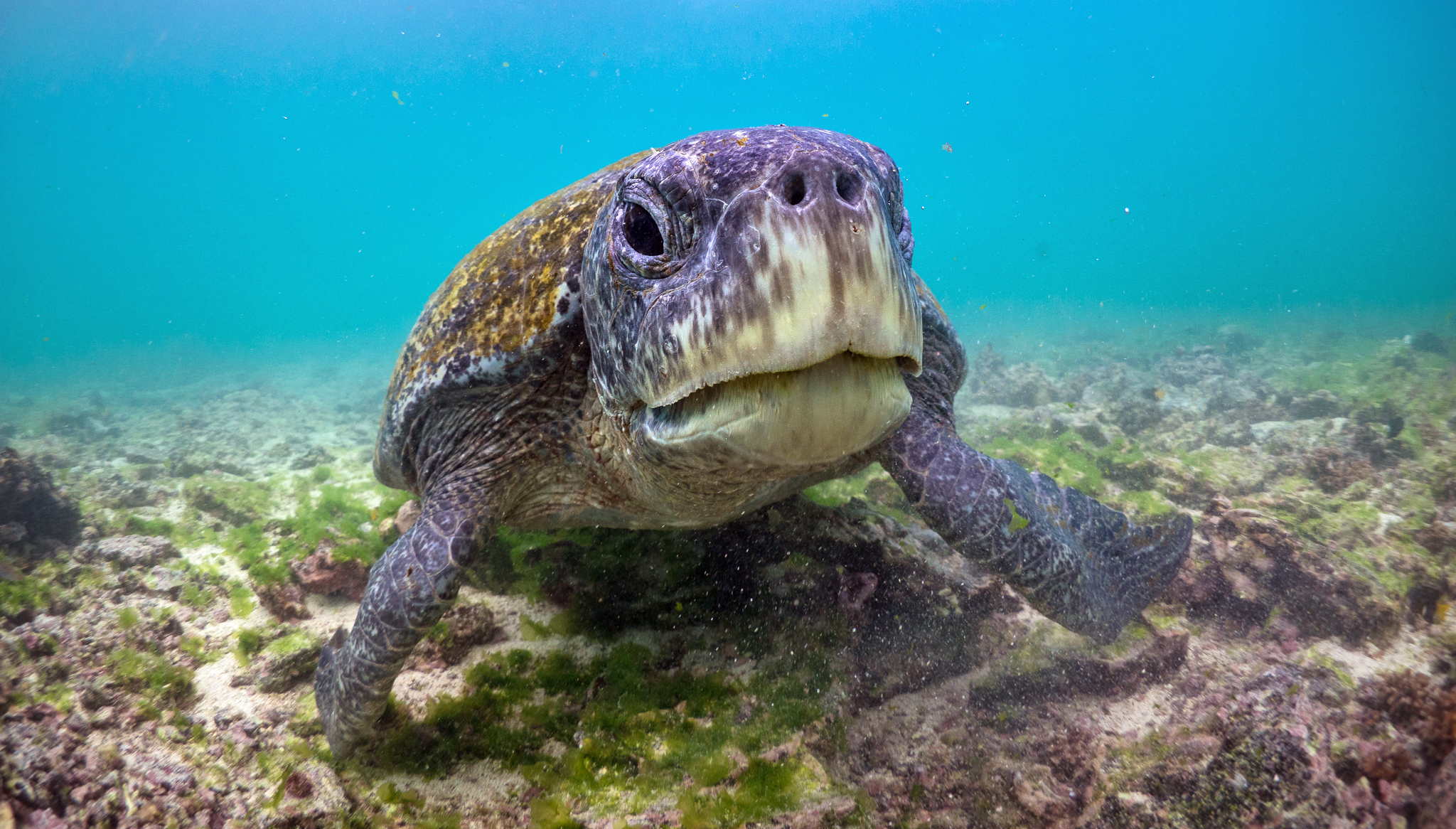
Wildlife & Marine Life
For some of the best marine life in the Galapagos, we will head to the far south west of Isabela Island, amongst a series if tiny lava islets. There is some fantastic snorkeling here, where our underwater targets will include schools of Golden Cownose Rays, Green Turtles and White-tip Reef Sharks which swim amongst tree roots and pack into a tiny cave we can spy into. On top of these islets we can find nesting Blue-footed boobies, which in June will be performing their famous courtship displays. Offshore we find rocks where Nazca Boobies roost and waters where we can sometimes see a Hammerhead Shark, Mobula or Manta Ray close to the surface.
South Plaza is another particularly beautiful island we will visit, characterised by Opuntia, or prickly pear trees; and endemic sea purslane plants. South Plaza also has some dramatic sea cliffs, filled with seabirds; whilst on its gentler slopes we can find plenty of land iguanas, swallow-tailed gulls and all grey lava gulls.
One of the other great marine highlights we visit on this trip, is a channel that runs through a huge split in Kicker Rock (Leon Dormido), which lies just off San Cristobal Island. What we can always be sure of here is the drama of the scenery, enjoyed looking up from the water. Birdlife in the form of Blue-footed boobies, Nazca boobies and Magnificent Frigatebirds are quite likely to fly overhead, whilst at the sea surface, turtles often pop up close by. If visibility allows, you will be able to see beneath you a huge amount of sea life. Leader, Ralph Pannell, has seen as many as 200 Galapagos Sharks here, holding their position in the current, as well as schools of as many as eight Hammerhead Sharks and beautiful Blue Spotted Rays gliding gently past. It is not unusual for us to see 40 or more green turtles on a single snorkel here. The record breaking freediver, Tanya Streeter, rated the Galapagos as the best place in the World to freedive and snorkel.
Photography & Insights
We will have lots of opportunities for photography on this trip, with assistance on the go, evening reviews as requested; and any advice you need before you head to the islands. We will also provide talks about the wildlife, marine life and geology of these most special islands, including Galapagos shark research these trips help to fund.
Seeing more of Ecuador & the Galapagos
If before this Galapagos trip you would like to see some of mainland Ecuador, Aqua-Firma director & photographer Ralph Pannell, formerly of the charity Rainforest Concern, will be leading an 11-day journey combining the most biodiverse area of our planet: the Tropical Andes … with our biggest tropical wilderness: the Amazon. Visit or Tropical Andes to Amazon page for details.
To see more of the terrestrial wildlife, marine life, fantastic scenery and diverse habitats of the Galapagos, we can take you onboard a selection of Wildlife Yacht Safaris through the islands. Please Contact Us for options.
For those who scuba dive, immediately after this land-based Galapagos trip, you can join our marine biologist host from the Marine Megafauna Foundation, onto one of our Galapagos Shark Research Insights & Photography dive liveaboards.
Itinerary
8 Day Wildlife & Marine Life of the Galapagos itinerary
null
Day 1 – San Cristobal
Our journey begins at San Cristobal airport, from where you will be transferred to your hotel in the small seaside town of Puerto Baquerizo.
Once you have settled in, your trip host will then walk you to the Galapagos Interpretation Center and a beach where we can find rock pools and beaches littered with resting Galapagos sealions. Photo opportunities are wonderful.
Day 2 – Kicker Rock
This morning we will head out to Kicker Rock (Leon Dormido) in search of spectacular coastal scenery, birdlife and snorkeling amongst abundant marine life.
This afternoon, you will have the chance to top up on rock pool and sealion photographs if you wish.
Day 3 – San Cristobal Highlands & Santa Cruz
Beyond the magnificent seascapes, some islands in the archipelago have stunning highlands; San Cristobal is one of them. The altitude creates a special environment for animals and plants. El Junco Lagoon, The Breeding Center and Puerto Chino Beach are the places we will visit today.
El Junco lagoon, 700m above sea level, is one of the few permanent freshwater bodies in the Galapagos. Frigatebirds are often seen here washing the salt from their feathers, as well as White-cheeked Pintails and Common Gallinules. The lagoon's name comes from a type of plant common in this area, the "junco".
In the breeding centre, we can see the giant tortoises in their natural habitat and learn more about their origin and evolution.
Puerto Chino is a small white sand beach surrounded by dry lava, rocks and mangroves. During high tide the entire beach is covered by the sea. Upon arrival one is greeted by the sounds of many sea birds including blue footed boobies and brown pelicans resting after diving for fish. Lava lizards and sally lightfoot crabs run around the lava.
In the afternoon, we will take a speed boat across to Santa Cruz Island, spending the night in Puerto Ayora.
Day 4 – South Plaza Island
Today we will head out by small boat to South Plaza Island.
South Plaza is a beautiful island formed out of lava which bubbled up to the sea surface. It is relatively small but very diverse in its botany, full of birdlife and very good for spotting Land Iguanas. There are approximately 1,000 Galapagos Sealions on the island and birdlife is plentiful. Cliffs on the western side are nesting sites for Blue-footed and Nazca Boobies, whilst we can find Darwin's Finches amongst the rocks of the eastern side, Lava Gulls and lovely Swallow-tail Gulls.
Overnight in Puerto Ayora.
Day 5 – Puerto Ayora & Isabela Island
This morning is free for you to explore the biggest town in the Galapagos, with its many shops, cafes and restaurants; and perhaps pay a visit to the famous Charles Darwin Research Station.
Early afternoon, we will take you by speed boat about 2 hours from Santa Cruz to Isabela Island.
We will check into a hotel on the coast before exploring mangroves and lagoons in search of Flamingos, marine iguanas, Yellow-legs and different types of Darwin's finches.
Day 6 – Isabela
Early morning we will take a speed boat to the far south western tip of Isabela Island. Along the way we will pass by rocks where Nazca Boobies roost. We will eventually ride the surf into a series of tiny lava islets - a unique and beautiful coastal scenery where we can come across Blue-footed Booby nests with fledglings, lava lizards and Opuntia cacti.
For one of the best marine life snorkelling opportunities in the whole archipelago, we will move to a mangrove-fringed bay where we have great chances of swimming with White-tip Reef Sharks, schools of Golden Cownose Rays and Green Turtles.
We will head back to Puerto Villamil later on where you can relax, or join your hosts for a gentle bike ride along the south coast to areas where we can usually find hundreds of Marine Iguanas warming themselves on black volcanic rocks; and Lava Herons pursuing Sally Lightfoot crabs. This is a highly varied area, with vast golden sand beaches, rocks pools, pockets of mangrove forest, Opuntia cactus trees and views out over vast inland areas of sparsely vegetated lava fields.
Day 7 - Volcan Sierra Negra & Las Tintoreras, Isabela
This morning, we will head inland to the Sierra Negra Volcano in search of dramatic vistas and terrestrial wildlife.
The southeast of Isabela Island has yet more islets we will snorkel and walk amongst this afternoon. Photographic opportunities here are excellent, both above and below the water. Above water, we can walk amongst large groups of marine iguanas at various stages of development; watch Lava Herons stalk the bright red and yellow Sally Lightfoot Crabs; and gaze a two dozen or more White-tip Reef Sharks basking in foot-deep sea-filled lava channels. Blue footed boobies, Nazca boobies and sometimes Galapagos Penguins can be seen here. Below the water, we can enjoy some of the best opportunities for shallow-water snorkeling with green turtles, Mexican hogfish and marine iguanas as they swim across the lagoons. Lava lizards and sealions are likely to lie about our trails, so never put your camera away!
Day 8 – Isabela to Baltra
We will take a speed boat this morning, back to Puerto Ayora on Santa Cruz Island; and then tranfer overland and by boat to Baltra Island airport ready to fly back to mainland Ecuador .... or continue your exploration of the Galapagos, such as our Galapagos Shark Insights & Photography Dive Liveaboard which this trip is designed to link straight into.
Dates
Single room occupancy supplement £625 / US$720
+ £45 / $50 in 2024
Prices include
All transfers by land and sea
Accommodation
Expert guided exploration as per itinerary
Evening talks
Breakfasts & lunches
Snorkelling equipment if needed
Contribution to Galapagos Research
Not included
Flights to / from the Galapagos
Galapagos National Park fee (US$100*)
INGALA immigration fee ($20*)
Dinners
Tips
Excess baggage fees
(*correct at the time of writing - payable locally - may be subject to change without notice)

